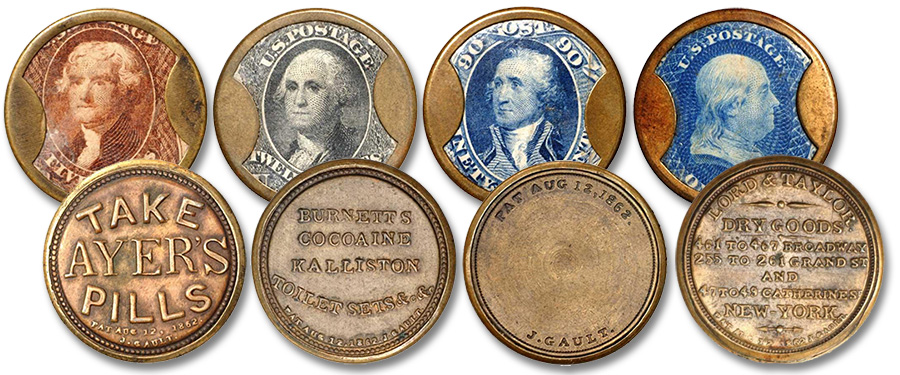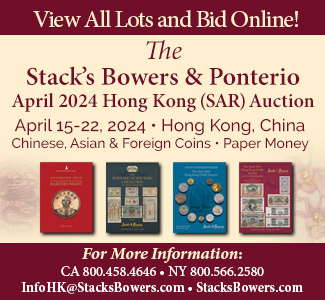
By Q. David Bowers – Co-founder, Stack’s Bowers ……
Lord & Taylor, the famous fashion retailer, is no longer with us, or at least not in its usual form. On August 3, 2020, the firm announced Chapter 11 bankruptcy protection and stated it planned to close all 24 of its stores.
Numismatically, Lord & Taylor is well-remembered for its issuance of encased postage stamps.
In the second week of July 1862, with no silver or gold coins in sight, and the channels of commerce awash in paper bills, even copper-nickel cents were hoarded. It was impossible to find a coin to buy a newspaper, get a haircut, or take a ride on a horse-drawn car.
Breaching the gap, many merchants, towns, and others issued tickets imprinted with values from one cent onward; paper money scrip notes with three cents and five cents were the most popular, but other values went up to a dollar or more. In time, many merchants issued bronze tokens, the size of a cent, which served for that value.
In the meantime, both the Confederacy and the Union were issuing more and more paper money. On February 25, 1862, the first “greenback” bills were authorized, these being called such because of the color of the reverse. By June 1862, over $100,000,000 worth of greenbacks flooded the North.
Silver and gold coins sold at increasing premiums, with changing rates published in the daily papers. In New York City in July, the premium on silver coins was 5% to 6%, meaning that it took $105 in greenbacks to buy $100 in federal coins.
On July 11, it took $130.
Horace Greeley, proprietor of the New York Tribune, suggested on July 9, 1862, that ordinary postage stamps could be used as change, these being conveniently pasted onto the bottom of a small piece of paper, the top being folded over. The idea achieved some popularity, mostly by taking the form of loose postage stamps in small envelopes imprinted on the front with a value such as 25¢. Others took postage stamps and pasted them to small pieces of cardboard. The idea caught on, and the Treasury Department began experimenting with such.
On July 14, Secretary of the Treasury Salmon P. Chase suggested to Congress that government stamps be made official as legal tender for small transactions. In the meantime, Treasurer Francis E. Spinner had pasted postage stamps onto sheets of Treasury Department letterhead paper, cut down, and bearing his signature, together with stamps amounting to 5¢, 10¢, 25¢, and 50¢. He contacted the local post office and made an arrangement that stamps that were damaged should be redeemed at face value for new ones.
In response to Chase’s request, the Act of July 17, 1862, provided for the use of postage stamps for monetary transactions, including that by August 1 stamps would be exchangeable for Legal Tender “greenback” notes at all Treasury offices. They were also receivable for government obligations in amounts under $5, but they were not given official legal tender status, despite the Chase’s request.
In August 1862, Postage Currency notes were issued, featuring the same designs as postage stamps but in the shape of small pieces of paper money with additional inscriptions and with perforated edges. At first these were distributed to Army paymasters, then in September to the general public. By early 1863 about $100,000 of these flimsy little bills reached circulation per day.
The great public confusion regarding the use of stamps and early issues of Postage Currency is delineated at length in The Standard Catalogue of Encased Postage Stamps (1989), by Michael J. Hodder and Q. David Bowers, created in part with advice from John J. Ford, Jr., who encouraged the project. Now long out of print, copies of this book can be found on the internet.
During this time 31 different merchants signed up to advertise on encased postage stamps, invented by John Gault. Early issues bear Gault’s own imprint and, beginning later in the year 1862, after he joined Joseph Kirkpatrick in the formation of Kirkpatrick & Gault, 1 Park Place, the name of the new company was used.
At the turn of the 20th century a great numismatic interest arose in coins, tokens, and medals of all kinds. This was spurred in no small way by the efforts of Lyman H. Low, who published extensively on the series of Hard Times tokens (generally 1832-1844) including Hard Times Tokens (1900), which sold widely; and the writings of Dr. Benjamin Wright in the pages of The Numismatist. It is probably correct to say that if one area in the market was “hot” at the turn of the 20th century, it was what we call “exonumia” today – tokens, medals, and related items. Interest in modern federal coins was fairly low, production figures of Proofs ordered had been dropping since the 1880s, and most collectors sought items with a “story”, not a succession of dates of the same design. Mintmarks were collected only by a few, and hardly anyone cared what was happening at the branch mints. Things certainly have changed since this long-ago time!
From the 1880s onward, encased postage stamps became known to an ever-widening circle of collectors. Charles Gregory, a stamp collector from New York City, had acquired some pieces from Gault, and in 1889 provided a list of his pieces to the Philatelic Journal of America. Examples appeared within auctions with some regularity during the first decade of the 20th century, ranging from mainstream sellers to second-tier catalogers such as Benjamin Green of Chicago.
In later years, encased postage stamps continued to be popular with specialists, often joining tokens and medals in a cabinet, this being the case with John J. Ford, Jr., one of the most prominent in a long series of distinguished names of those active in the series.
Identification numbers for postage stamps were provided in philatelic catalogs issued by Scott. Separately, beginning in 1953, they could be found Paper Money of the United States, by Robert Friedberg, not to overlook many other listings, and articles here and there. Today, collectors primarily use the EP numbers by Friedberg, the HB numbers by Hodder and Bowers, and the numbers proposed by Fred Reed in his later text (with expanded historical information). The Hodder and Bowers publication, with much information provided by Robert Kincaid, John Ford, and others, was the first to include an extensive amount of historical and background information in a single volume.
Encased postage stamps offer a rich possibility to collect “go-with” pieces: products and items associated with the issuers.
During the 1860s Dr. J.C. Ayer, whose name was forever memorialized in the town of Ayer, Massachusetts (to which Groton Junction changed its name after Ayer’s family donated the town hall), was an entrepreneur per excellence. No holds were barred in making claims for his patent medicine, including Cathartic Pills, Ayer’s Pills (generic), and Ayer’s Sarsaparilla, each extensively advertised on encased postage and thus is among the more collectible issues today. Ayer also issued yearly almanacs in quantity, and the bottles containing his products are easily found in antique stores, particularly in the Northeast. Boxes of pills exist also, but are not as easily found.
Joseph L. Bates, dealer in “fancy goods” in Boston, put his imprint on different products, some of which can be found today, including stereograph slide viewers. Brown’s Bronchial Troches, said to be good for coughs and colds, endured for years after the encased postage stamps were made, and, similar to the products of Ayer, were advertised widely in many forms, including almanacs.
In Boston, Joseph Burnett & Company advertised Standard Cooking Extracts of lemon, vanilla, almond rose, etc., on encased postage stamps, and the small clear glass bottles for these products can be found today. Somewhat more elusive are bottles for Burnett’s Cocoaine, Kalliston, and “toilet sets”. Cocoaine was a hair tonic based on coconut oil and had nothing to do with the drug cocaine. Kalliston, from the Greek word kalli, meaning “beauty”, identified a skin cream and dandruff remover.
As to the toilet sets, the writers have not encountered samples, and perhaps they were not imprinted, but the opportunity beckons for a new discovery.
Drake’s Plantation Bitters, sold in log cabin-shaped amber bottles, advertised extensively in encased postage stamps. The bottles themselves are readily obtainable as well and make a nice display. Going down the list, the name of Lord & Taylor, dry goods dealers of New York City, is still familiar today, and the products of the firm are endless, although, as noted above, this retailer too will become a thing of the past. The point of this discussion is that while encased postage stamps are interesting in themselves as small numismatic items worth collecting and studying, the history for each is fascinating, and related artifacts if they can be obtained, add to the pleasure.




